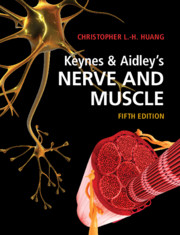Book contents
- Keynes & Aidley’s Nerve and Muscle
- Keynes & Aidley’s Nerve and Muscle
- Copyright page
- Dedication
- Contents
- Preface
- Acknowledgements
- Abbreviations used in the text
- 1 Structural Organisation of the Nervous System
- 2 Resting and Action Potentials
- 3 Background Ionic Homeostasis of Excitable Cells
- 4 Membrane Permeability Changes During Excitation
- 5 Voltage-Gated Ion Channels
- 6 Cable Theory and Saltatory Conduction
- 7 Neuromuscular Transmission
- 8 Synaptic Transmission in the Nervous System
- 9 The Mechanism of Contraction in Skeletal Muscle
- 10 The Activation of Skeletal Muscle
- 11 Excitation–Contraction Coupling in Skeletal Muscle
- 12 Contractile Function in Skeletal Muscle
- 13 Cardiac Muscle
- 14 Ion Channel Function and Cardiac Arrhythmogenesis
- 15 Smooth Muscle
- Further Reading
- References
- Index
10 - The Activation of Skeletal Muscle
Published online by Cambridge University Press: 07 November 2020
- Keynes & Aidley’s Nerve and Muscle
- Keynes & Aidley’s Nerve and Muscle
- Copyright page
- Dedication
- Contents
- Preface
- Acknowledgements
- Abbreviations used in the text
- 1 Structural Organisation of the Nervous System
- 2 Resting and Action Potentials
- 3 Background Ionic Homeostasis of Excitable Cells
- 4 Membrane Permeability Changes During Excitation
- 5 Voltage-Gated Ion Channels
- 6 Cable Theory and Saltatory Conduction
- 7 Neuromuscular Transmission
- 8 Synaptic Transmission in the Nervous System
- 9 The Mechanism of Contraction in Skeletal Muscle
- 10 The Activation of Skeletal Muscle
- 11 Excitation–Contraction Coupling in Skeletal Muscle
- 12 Contractile Function in Skeletal Muscle
- 13 Cardiac Muscle
- 14 Ion Channel Function and Cardiac Arrhythmogenesis
- 15 Smooth Muscle
- Further Reading
- References
- Index
Summary
Vertebrate skeletal muscle has a negative, -90 mV, resting potential arising from Na+-K+-ATPase-generated transmembrane ionic gradients and inwardly rectifying K+, and Cl- membrane conductances. Three-electrode and loose-patch voltage-clamp experiments demonstrated that, as in nerve, muscle action potentials involve voltage-dependent Na+ followed by K+ channel activation. An additional transverse tubular action potential contributes a discrete and separable delayed component to the recorded voltage change. It is triggered by low-frequency components of the surface-membrane action-potential leaving high-frequency components to ensure rapid propagation of the surface wave. Tubular Cl- conductances decrease in both fast and slow twitch muscle and ATP-dependent K+ channel conductances increase in fast twitch muscle, in early and prolonged exercise. Mathematical modelling demonstrates that these respectively enhance and reduce tubular excitability and its triggering of contractile activity. They potentially furnish enhancing and fatiguing mechanisms for muscle activation and for clinical myotonia congenita.
Keywords
- Type
- Chapter
- Information
- Keynes & Aidley's Nerve and Muscle , pp. 135 - 153Publisher: Cambridge University PressPrint publication year: 2020



